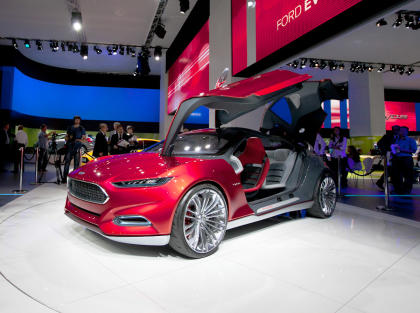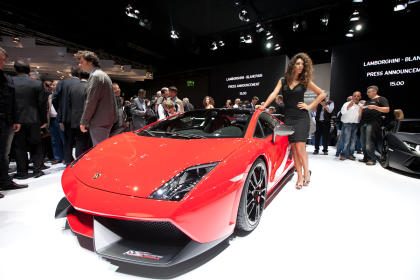2011 Frankfurt Auto Show
As a kickoff to Oktoberfest, the world's largest auto show runs through September 25. In a jittery global economy, manufacturers focus on fuel efficiency.
MORE AT YAHOO! AUTOS
Every year just before Oktoberfest, Germany harvests a bumper crop of new cars at the International Automobile Exposition (also known as the Frankfurt Auto Show). Audis, BMWs, Mercedes-Benzes, and Volkwagens galore soak up several kilowatts worth of spotlight on their home turf. It's the kickoff week for a national festival of engineering innovations, automotive masterpieces, and beer.
At this year's Frankfurt show, however, an American stole the show when Ford unveiled the Evos, a concept car with butterfly doors. Although the fancy doors are only for show and won't be seen at Ford dealerships in the near future, the car's overall shape is likely an indication of things to come. Much of the underlying technology could make it to market soon as well. The Evos is a plug-in hybrid, which suggests that Ford executives noticed Toyota displaying a sales-ready plug-in Prius PHEV (which debuted as a concept in Frankfurt just two years ago) in its booth. A plug-in similar to the Evos could make its way to market in a similar time frame.
Ford’s current product line benefits mostly from turbocharging. For instance, cars like the new Focus ST (which we may see in the U.S.) and Fiesta ST (which we may not, given that the three-door version of Ford’s subcompact isn’t sold stateside) use turbos. Alongside these hot hatches was a new version of the venerable Formula Ford racing car. The open-wheel racer’s powered by a 1.6-liter turbocharged four-cylinder, much like the engine in the Fiesta. Ford also pulled the wraps off a 1-liter turbo three-cylinder Fiesta that gets 45 mpg. If this engine comes to the U.S. — as Ford has previously suggested — expect it to replace the Fiesta’s naturally-aspirated 1.6-liter and possibly also appear in the Focus.
European Highlights
Leaping upmarket, Jaguar rolled out a stunner penned by Ian Callum. The C-X16 (which will likely be called the XE when it comes to production) combines a supercharged V-6 with a hybrid designed to improve power. At the touch of a button, this Jag's electric motor supplies a 94-horsepower boost for ten seconds; sort of like a nitrous bottle that never requires refilling. Far from gimmickry, hybrids are indeed coming to sports cars. Set to slot in below the XK in Jaguar’s sporting lineup, the XE’s designed to take on the BMW Z4 and Porsche’s Boxster/Cayman twins. The XE will likely keep the hybrid, if only to justify the "E" in its name.
This wouldn't be Frankfurt without heavy helpings of German cars. Porsche, Stuttgart’s sports-car überhaus, is developing a hybrid 911, which should arrive by 2016. In the interim, the company’s big news from Frankfurt was the latest 911 (known to Porsche enthusiasts as the 991). Bigger (a hybrid has to fit somewhere) and lighter than the outgoing car, the new 911 will be available with either Porsche’s PDK automated manual transmission or seven-speed manual.
Other high-dollar sports-car makers hewed to the formula of a decade ago, when power and performance were the sole kings of the realm. Ferrari unveiled the convertible version of its mid-engined 458, while Lamborghini continued to wring sales out of the aging Gallardo with another special edition.
Lamborghini Gallardo Special Edition
The Gallardo’s introduction in 2003 proved a watershed moment in the company’s history, as well as that of parent Volkswagen. Once known for elegant touring cars that gave way to alien exotics typified by the outrageous Countach, Lamborghini announced it was playing for keeps in the supercar market with the fast-yet-dependable V-10 Gallardo.
Stunning as it is, the model is now growing a bit long in the sharpened tooth, with a new version not due for a few years. Ergo, enter a hot rodded version of the car this year in Frankfurt: dubbed the Super Trofeo Stradale, it boasts a race-worthy carbon fiber wing, lightened interior brimming with carbon and Alcantara and the same fire-breathing 565 hp found in the company’s ferocious Superleggera.
Lambo’s tweaking is familiar to anyone following the marketing moves of Aston Martin, Porsche and most notably Ferrari, whose Challenge Stradale vehicles are street-going iterations of machines made available for the company’s gentleman-racer series. Ditto the Trofeo Stradale, which offers Richy Rich-drivers the chance to chase each other around famous circuits in the Lamborghini Blancpain Super Trofeo racing series. Or, you can just drive to the local mall and freak out the locals with the flick of a toe.
The LP 570-4 Super Trofeo Stradale starts at over $200,000, and goes 199 mph. The company will sell all 150 copies. More interestingly, the Sant’Agata Bolognese supercar factory announced that it’s building 20 copies of the Sesto Elemento, a super-lightweight machine powered by the Gallardo’s V-10 rather than the traditional range-topping V-12. Though pricing was not announced, it’s certainly in the millions; figures bandied about range from $1.2 to $2.7 million. What’s interesting about the Sesto Elemento isn’t the rarity, price, or performance; it’s the emphasis on materials and light weight. We’re huge proponents of taking weight out of vehicles. It’s the one place we can reconcile our enthusiasm for performance with our desire for green credentials. Lighter cars require less power for equal performance, need smaller brakes, wheels and tires, all of which lead to more nimble handling, better road feel and naturally, lower fuel consumption.

 Yahoo Autos
Yahoo Autos 



